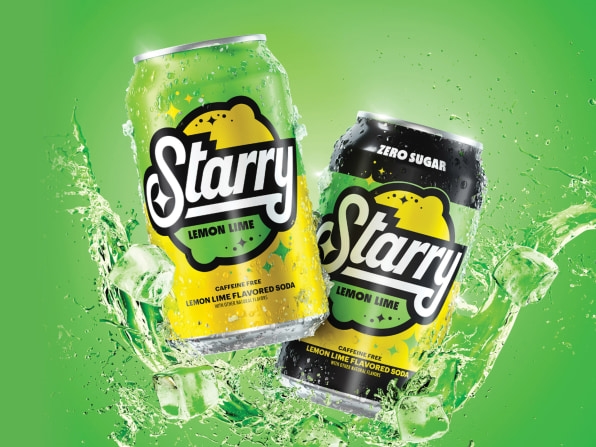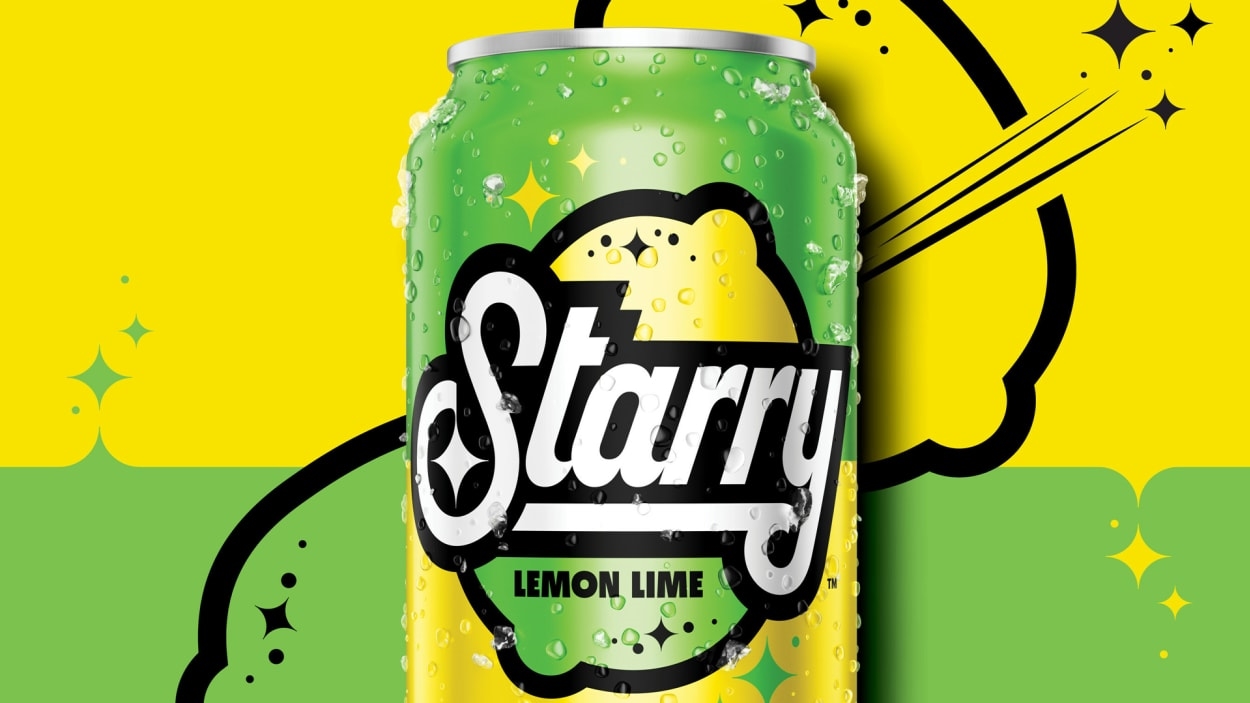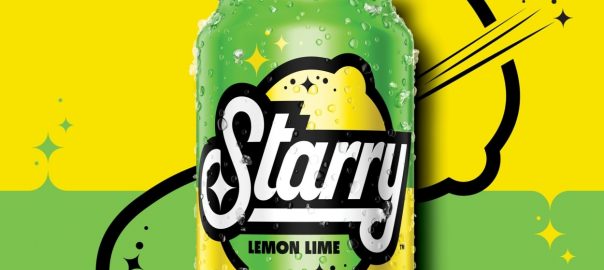Ever since Pepsi first pitched itself to your parents and grandparents as a youth-focused brand back in 1963—“Come alive! You’re in the Pepsi Generation!”—there has been a steady stream of soda marketing and entire brand launches conceived for the sole purpose of enticing young, cool, (and lucrative) tastebuds.
Now, PepsiCo has launched the latest incarnation of generation carbonation. It’s lemon, it’s lime, it’s Starry!
Starry’s launch materials from earlier this month offered that the demand for lemon-lime flavored soda has grown significantly since 2019, opening up an opportunity for a crack at a big gulp Goliath. “With one product dominating the category, consumers deserve another option . . . one that hits different,” Greg Lyons, chief marketing officer at PepsiCo Beverages North America, said in a statement. “Starry is bright, optimistic, and rooted in culture and fun.”
You’d be forgiven for wondering what makes a soda optimistic or bright; I don’t know either. But here’s what I do know: PepsiCo is specifically aiming Starry at Gen Z—and now things come into focus. Gen Z likes bright, contrasting colors! Gen Z is reputedly optimistic! Gen Z is redefining fun! Starry is so Gen Z. It’s just like Gen Z! Another five minutes of googling, and I could have made the case that Gen Z is pessimistic, prefers neutral to bright colors, and is despondent.
While establishing a certain brand image is undoubtedly important, reducing it to an age range and a grab bag of supposedly generational traits is perhaps the most dangerous mirage in marketing. On a pitch deck, it appears strategically specific, but in reality segmenting your consumers by age or generation is absurdly broad.
The sugar-water graveyard is littered with brands so thirsty for youthful acceptance that they trend-chased their way into oblivion. Just as it is a rite of passage to feel misunderstood by your elders, so too is targeting every generation’s cohort between 12 and 25 as the most desirable demographic. Baby boomers, Generation X, millennials, and now Gen Z have had their moment in the glare of brand marketers’ gaze. (And don’t think for a second that Gen Alpha targeting hasn’t already begun as they age into the spotlight.) For each generation, brands have tailored their messaging, images, media strategies, and celebrity spokespeople to entice, engage, and enthrall young eyeballs with the intent to boost sales and, ideally, lay the foundation for lifetime loyalty.

PepsiCo, Starry’s parent company, is no stranger to generational targeting. From the “Pepsi Generation” of the ’60s, the namesake soda went all in in 1984 with its infamous Michael Jackson commercial, touting itself as “the choice of a new generation”—a tagline that ran from 1984 to 1991, with the intent of attracting the generation coming up after the boomers (and years before Douglas Coupland coined the moniker Generation X). Then in 1997, the pitch became “Generation next,” which included an appropriately zeitgeist-y Spice Girls spot that aimed to excite younger Gen X and the millennials who already were starting to usurp them.
Despite all that star power, the closest Pepsi ever came to winning the Cola Wars was in 1983, when its focus was not any given generational divide, but taste. The Pepsi Challenge was a simple concept: Invite random people in random malls to take a blind taste test between Coke and Pepsi, and tout the favorable results. In fact, people picked Pepsi over Coke by a significant margin—surprising even Pepsi. This ad campaign was so effective, it’s credited with pushing Coca-Cola into arguably the biggest blunder in company history, New Coke.
“Truth About Age,” a 2017 McCann study, suggested marketers should shift from age to attitudinal segmentation, replacing age ranges with five different attitudes: Ageless Adventurers, Communal Caretakers, Actualizing Adults, Youth Chasers, and Future Fearers. Wherever you fit in there, the point is, it’s probably better to categorize people by their interests and likes and dislikes rather than the date on their birth certificate. This plays out in the real world with an advertising landscape that is riddled with cringe-inducing work trying to be young, while trying to pretend older people don’t exist.
If we’re to apply any historical lessons to Starry’s current ambitions, the 1990s are the best place to start. As clear beverage hype goes, you can’t get much more transparent than the decade that gave us Crystal Pepsi (1992), Tab Clear (1992), and the legendary clear beer alternative, Zima (1993). All of these were blatant attempts to capture a Gen X audience by touting these new products as made especially for them. None remain.

Perhaps the very best cautionary tale is a soda self-described in one ad as “carbonated tree sap.” This time it was Coca-Cola chasing Gen X, by launching OK Soda in 1993.
OK Soda tried really, really hard to embrace and embody the eye-rolling, cynical, laid back, whatever attitude ascribed to this generation on full display in such films as Richard Linklater’s Slacker and Ben Stiller’s Reality Bites. Brian Lanahan, a Coke marketing exec and manager of special projects at the time, told Time that a key part of the approach was being very self-aware about its marketing because Gen X was so well versed in commercial culture. “It underpromises,” Lanahan said. “It doesn’t say, ‘This is the next great thing.’ It’s the flip side of over-claiming, which is what teens perceive a lot of brands do.”
On paper, Coke made all the right brand moves, between enlisting Nike’s agency Wieden+Kennedy to create the design and brand image, and experimenting with oddball engagement, like setting up a 1-800 hotline. But it never took off. The company was never able to translate its manufactured cool into the real thing. OK Soda was eventually discontinued in 1995. Maybe it was the tree sap thing.
So far, we haven’t seen much of Starry beyond its logo and packaging. One TikTokker described the taste, “like 7Up and Mountain Dew had a baby.” Word is, it may have a role in PepsiCo’s overall Super Bowl plans but not star in its own big game ad.
A 2022 report from market research firm YPulse ranked the Top 50 Coolest Gen Z Brands, and just three beverage brands made the list: Gatorade came in at 23, Mountain Dew at 31, and Coca-Cola at 38.
Last May, Sprite—that’s right, the soda that Starry has to try to steal market share from—revealed its own generational generalization, launching its first-ever global campaign, dubbed “Heat Happens,” aimed at Gen Z across 200 markets around the world. It represented a shift away from its recent focus on sports superstars like LeBron James and Trae Young, and embraced a broader pitch around helping folks keep cool in frustrating situations. “We believe that Gen Z consumers live in a world that’s more heated than ever before,” Sprite’s global brand director Shrenik Dasani told The Drum in an impressively on-message quote.
Heated or not, history tells us that generational marketing rarely wins over any given age group. If Starry really wants to capture those bright, optimistic teens and twentysomethings, it’ll bet big on being creatively entertaining and drop the rest of the pretense. Otherwise, Starry’s future will never be more than just okay.
(27)







